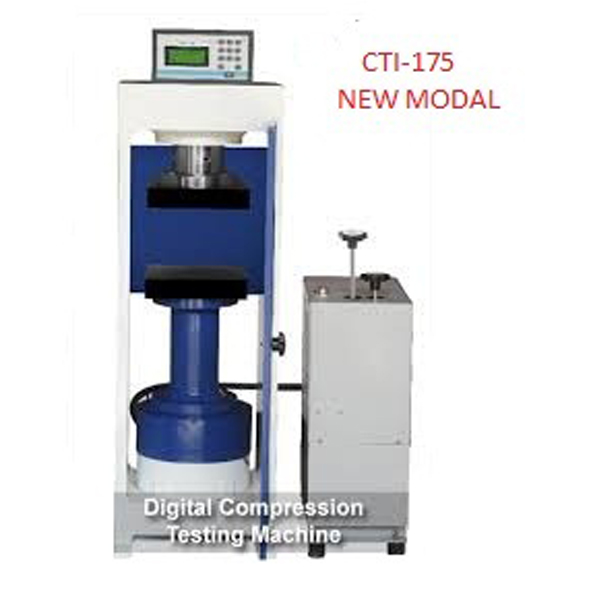|
(Electrical cum hand operated) |
|
|
|
Introduction |
This test is used to determine the compressive strength of a concrete cube, which has usually been made from fresh concrete cast in a standard test mould. The value of compressive strength can then be used to assess whether the batch that the concrete cube represents meets the required compressive strength. Following cube manufacture and curing, which should both be closely controlled, the cube is crushed at a stated constant speed until it can sustain no further increase in load. The strength is then derived by calculation using the maximum load and cube dimensions. |
|
|
|
|
The machine embodies an hydraulic system designed to meet the requirements of Indian standards Specification 516-1959 for compression tests on concrete cubes up to 20 cm X 20 cm X 20 cm. and also concrete cylinders up to 30 cm height. Using special platens and fixture, Brick testing and flexural testing can also be carried out on the same machine. |
|
|
|
Features |
-
Hard chrome plated piston with new type of long life oil seal.
-
Four Pillar Model - superior in design, reliability and accuracy
-
Practically no welded parts, all joints reinforced with heavy nut/bolt to withstand occasional over loading and to ensure center loading.
-
Rounded Corners – add to elegance and safeguard against injury
-
Hardened and grinded platens with guide lines for placing sample for testing
-
Accurately calibrated dial gauge
|
|
|
|
Lodaing Unit
|
General descriptions & Specifications |
|
|
The hydraulic jack of rated capacity is fixed to the base. The upper platen has got a self-aligning action and is attached to a screw, which passed through the crosshead plate, and can be raised or lowered for initial clearance adjustment. The lower platen rests on the jack ram and is positioned with the help of a centering pin. Loading is accomplished by upward movement of lower platen. A dust cover is provided on the jack to prevent any dust from going into the cylinder. A spacer with a centering locating pin is provided to test small specimens. The lower and upper platens of the machine are hardened ground and polished. Guidelines are marked on the lower platen to keep the specimen coaxial with the hydraulic jack. |
|
|
|
Pumping Unit
|
The motorized pumping unit which is housed in an elegant console is of double plunger type and is driven by three phase 440 volts 50 cycles electric motor. The pumping unit is a separate unit connected to the jack by means of a flexible high pressure connecting tube. A junction box is suitably fixed to connect the motor to the mains through a push button starter. The Pumping unit is fitted with hand wheel control valve, which enables the rate of application of load to be varied. The Machine is also equipped with facility for hand pumping in case of power failure |
|
|
|
Pressure Gauge
|
The pumping unit is fitted with a 20cm dia hydraulic pressure gauge with 200 divisions A max red pointer is provided to facilitate taking readings after failure of the specimen. The pressure gauge is fixed at an Angle for easy readability. The Pressure Gauge is accurately calibrated against MASTER `A` Class Proving Ring having traceability to National standards. |
|
|
|
Safety Features
|
The electric pumping unit is fixed with a micro-switch to switch off the motor automatically as the load on the machine approaches the rated capacity. Relays are incorporated inthe pumping unit so that in case of break down of power supply the motor will stop and would not re start unless the starting switch is operated. |
|
|
|
Capacities Available |
-
100 KN WITH SINGLE GAUGE / LEAST COUNT 0.5 KN
-
250 KN WITH SINGLE GAUGE/ LEAST COUNT 1.0 KN
-
500 KN WITH SINGLE OR DOUBLE GAUGE. (250 AND 500 KN)
-
1000 KN WITH SINGLE, DOUBLE OR TRIPPLE GAUGE (250/500/1000 KN)
-
1500KN WITH SINGLE, DOUBLE OR TRIPPLE GAUGE (500/1000/1500 KN)
-
2000 KN WITH SINGLE, DOUBLE OR TRIPPLE GAUGE (500/1000/2000 KN)
-
3000 KN WITH SINGLE, DOUBLE OR TRIPPLE GAUGE (1000/2000 /3000 KN)
|
|
|
|
Optional Accessories |
-
Spare Oil Seal
-
Brick Testing Attachment
This test measures the compressive strength of bricks to be used in construction for load bearing walls. Specimens are first sampled from batches in a standard manner. The bearing faces are then either made perfectly flat by capping with sulphur or soft wooden spacers are used to take up surface defects, this will avoid any point loading. If frogs are present (indentations in the face) then these are filled with standard mortar. The maximum load sustained by the bricks before failure is then measured and the compressive strength calculated.
-
Flexural Test Attachment
The test method essentially involves applying a load at the centre of a beam of concrete supported at its ends. The load required to break the specimen is then recorded.
-
Cube moulds of various sizes
-
Accelerated curing tank
-
Hydraulic oil (TIIN of 5 liters)
|
|
|

